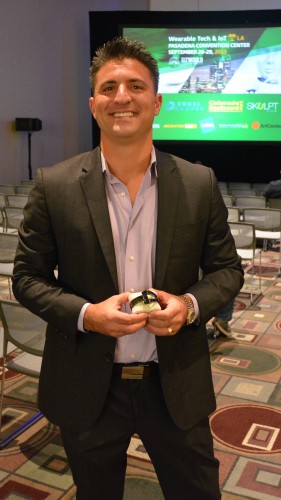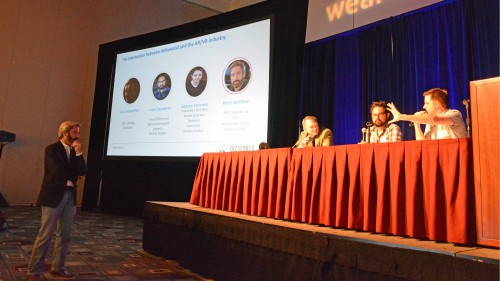by Dot Cannon
Will your future phone have hologram capability? How will the Internet of Things affect your future career?
And what IS “virtual reality”, anyway?
Those were just a few of the questions raised at Day 2 of Gizworld’s recent Wearable Tech LA Conference, in Pasadena. Undoubtedly, the discussion will continue at Wearable Tech and IOT Silicon Valley, October 27th and 28th.
Before Day 2’s presentations even started, panelist and WiseWear CEO/founder Dr. Gerald “Jerry” Wilmink showed us an ingenious new “wearable”.
This is from WiseWear’s new Socialite™ line of luxury jewelry. It’s a smart bracelet that tracks a woman’s health and safety!
Dr. Wilmink explained that, if a wearer finds herself in a situation where she feels unsafe, she can tap the bracelet three times. So, for example, a woman in a dark parking lot may do this when she sees a stranger approaching. The taps send a distress signal and her location to her pre-approved list of contacts. Then, if the situation escalates, additional taps will summon assistance.
Day 2 of Wearable Tech L.A. started with a keynote by Ashley Crowder, Co-Founder and CEO of VNTANA. Her company creates realistic holograms that can do anything from simulate a top artist’s live performance to create an onstage “twin” avatar for a performer!
“This was founded on the idea that we wanted artists to be able to play multiple locations at the same time,” Crowder told her audience. “There was nothing on the market that was affordable…so we built our own hardware.”
She also said VNTANA’s current innovations were just the beginning. Holograms, she commented, have the potential to change the education, healthcare and business landscapes.
“(Holograms) can give students experiences they’ve never had before,” Crowder said, “(and) let shoppers buy things when stores are closed.”
Another highlight was the morning’s first discussion panel. Pasadena’s Art Center College of Design sponsored the presentation, entitled “Leading with Design”.
Art Center faculty member Jeffrey Higashi introduced one wearable student project by first showing the devices on which it improved. These are previous devices used to monitor patients’ brainwaves to predict epileptic seizures. “You just can’t imagine wearing something like this to Target,” Higashi commented.
But, no one at the store is likely to give this new wearable, called “Wavelink”, a second look. It monitors brain waves while fitting into everyday life much more unobtrusively.
Even more mind-blowing innovations were coming.
Multimedia designer Jenny Rodenhouse talked about her recent graduate project for Art Center. Rodenhouse said her innovation started with visits to local nail salons. After observing the “salon culture”, she combined it with wearable technology…
 …and turned her apartment into a “sensor salon” for one day, where she and friends experimented with artificial nails with attachments for sensors. One possible use, she said, could be behavior modification.
…and turned her apartment into a “sensor salon” for one day, where she and friends experimented with artificial nails with attachments for sensors. One possible use, she said, could be behavior modification.
“The sensor nails could vibrate, as a person who wanted to quit smoking reached for a cigarette.”
In between sessions, these were some of our favorites from the exhibit floor. Here, OURA Operations Manager Markku Hooli displays the Oura Ring. This is a personal wellness monitor that measures your heart rate and sleep quality, to tell you how your body’s reacting to how well you’ve slept!
Here’s Skulpt® VP of Product Juan Jaramillo, demonstrating his company’s wearable device to measure body fat percentage.
And right next to this display was a quadcopter, for which this MakeIt 3D printer created the components!
In the afternoon, WorkTechWork founder Josh Bradshaw moderated a panel on “Successful Business Models for IOT”. Among the questions he and his panelists explored: “Why is developing a sustainable business model for the Internet of Things such a challenge?”
Cisco IOT Marketing Manager Ed Cho (center) said one obstacle was lack of standardization. “When we think about IOT, it’s not just one technology,” he commented. “…(We have) three things to get right: software, hardware and user experience.”
“We need to be helpful but not intrusive,” said entrepreneur and strategic advisor/investor Sugath Warnakulasuriya (right). “It’s a delicate line. I don’t want my sleep-monitor map to figure out I’m not sleeping and tell me what late-night restaurants are open!”
Drone Dudes’ presentation started with a video showcasing the ways drones are revolutionizing film production. Both time and money were considerations, they said.
“(With aerial shots), you’re talking about spending 50 grand on a helicopter for a day, versus 1 or grand for a drone team,” said Drone Dudes producer Ed Delahunty. “We’re the new kids on the block…it takes us 5 minutes to set up.”
But film production wasn’t the only area in which they highlighted drone use. In a Skype call with “wolf guy” Oliver Starr, the panel also discussed the use of drones to save endangered wildlife. One possibility, they agreed, was the use of camera-equipped drones at night, to guard animals against poachers and mines.
Towards the end of the call, Starr had his white wolf, Aqutaq, chime in with a howl!
The day ended with a candid discussion on “The Intersection Between Hollywood and the AR/VR Industry”. Led by moderator Barry Sandrew, of Augmented Vision Works, the panelists agreed that, currently, we really don’t know what virtual reality is!
“I think it’s going to be the first platform that is fully flexible,” offered Mirada Studios Visual Effects and Special Projects Supervisor Julian Sarmiento.
“You have to stop thinking of yourself as a film director and start thinking of yourself as an experience designer,” said Mirada Studios Interactive and New Media Director Andrew Cochrane.
Oblong Industries CEO John Underkoffler commented, “The real precedents of what’s coming are not with us. Look to sci-fi books.”















